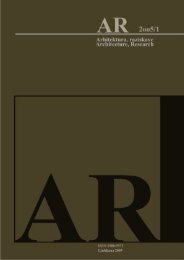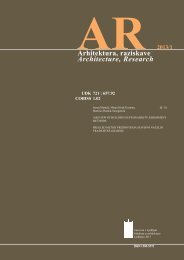VeÄ - Fakulteta za arhitekturo - Univerza v Ljubljani
VeÄ - Fakulteta za arhitekturo - Univerza v Ljubljani
VeÄ - Fakulteta za arhitekturo - Univerza v Ljubljani
You also want an ePaper? Increase the reach of your titles
YUMPU automatically turns print PDFs into web optimized ePapers that Google loves.
4.10.7 DETAJL V ARHITEKTURNI KOMPOZICIJI 2<br />
DETAIL IN ARCHITECTURAL COMPOSITION 2<br />
doc. dr. Igor Kalèiè, univ. dipl. inž. arh.<br />
izbirni predmeti elective subjects<br />
Detajl je najmanjši, pa morda najpomembnejši element arhitekturnega jezika. Predmet Detajl 2 je nadgradnja predmeta Detajl 1 in uvaja<br />
študenta v <strong>za</strong>snovo in oblikovanje detajlov z bolj <strong>za</strong>htevnimi in bolj kompleksnimi materiali. Pri tem gre predvsem <strong>za</strong> sestavljanje razliènih<br />
materialov v nove kompozicije – sklope: kovina in steklo, les in beton, les in steklo, kamen in beton, kovina in les, ... ali še bolj <strong>za</strong>pleteno in<br />
kompleksno: beton, kovina in steklo, beton, kovina in les, kovina, les in steklo itd. Pri sestavljanju razliènih materialov v sklope veljajo drugaèna<br />
»pravila igre« kot pri bolj enostavnih kombinacijah enakih materialov. Predmet uvaja pri oblikovanju detajlov neke nove parametre, bolj<br />
inženirske narave in obvezno tudi ekonomski faktor (racionalnost), kot vèasih kar prevladujoè pri sprejemanju odloèitev. Pravila igre so pri tem<br />
sestavljanju strogo tehnološke narave in upoštevajo rešitve iz fizike in kemije in druge pomembne inženirske aspekte. Zadnja fa<strong>za</strong> tega<br />
procesa <strong>za</strong>snove in oblikovanja detajlov je tudi estetska komponenta, ki <strong>za</strong>gotavlja, da bodo konèni izdelki (sklopi in s tem tudi zgradba)<br />
všeèni, lepi in da bodo uporabnikom ustvarjali estetsko <strong>za</strong>dovoljstvo. Študentje morajo v okviru predmeta z mentorskim nadzorom,<br />
multidisciplinarno, osvešèeno in skladno z vsemi naèeli sodobnega evropskega inženirstva, izdelati detajlni projekt bolj kompleksne zgradbe (ki<br />
vsebuje bolj <strong>za</strong>htevne konstrukcije in kombinacije bolj <strong>za</strong>htevnih sklopov razliènih materialov), predstavljen na sodoben naèin z uporabo enega<br />
od splošno priznanih raèunalniških programov, ki se uporabljajo v inženirski arhitekturi (AutoCad, ArchiCad, 3D Studio Max, AllPlan FT<br />
Nemetschek ...).<br />
The detail is the smallest but probably the most important element of architectural language. The subject is a continuation of the subject Detail 1<br />
and introduces students to design of details with more demanding and complex materials, whereby the topic is combination of various materials<br />
into new compositions – modules: metal and glass, wood and concrete, wood and glass, stone and concrete, metal and wood etc., but also<br />
even more exacting and complex combinations: concrete, metal and glass, concrete, metal and wood, metal, wood and glass etc. When<br />
combining various materials into modules, “rules of the game” are applied, which are different than those in simple combinations of equal<br />
materials. In the design of details the subject introduces new parameters that are closer to engineering, as well as the compulsory economic<br />
factor (rationality), which is often the dominant factor in decision-making. The rules of the game for such composition are strictly technological<br />
and follow solutions taken from physics, chemistry and other important engineering aspects. The last phase of the process of conceptualisation<br />
and design is the aesthetic component. Which ensures that the final product (joint, but also the building) will be attractive, beautiful and will<br />
provide users with aesthetic satisfaction. Within the framework of the subject and under tutorage by a mentor, while abiding to principles of<br />
multi-disciplinary work, awareness and contemporary European engineering, students have to design a detailed project of a more complex<br />
building (which includes reinforced concrete, timber and steel constructions, and use of more exacting and complicated constructions and<br />
combinations of more demanding complex joints of various materials) and present it in a contemporary fashion by using generally acknowledged<br />
software programmes used in architectural engineering (AutoCad, ArchiCad, 3Dstudio Max, AllPlan FT Nemetschek etc.).<br />
- Krier, R.: Architectural Composition, Academy Editions, London 1991<br />
- Bre<strong>za</strong>r, V.: Finali<strong>za</strong>cija in detajli, skripta, FAGG, Ljubljana 1990<br />
- Papadakis, A.: Theory & Experimentation, Academy Editions, London 1993<br />
- Cook, P.; Jones, R.L.: New Spirit in Architecture, Rizzoli, New York, 1991<br />
104 dodiplomski študij graduate course<br />
smer/orientation<br />
orientation: ARHITEKTURA / ARCHITECTURE

















